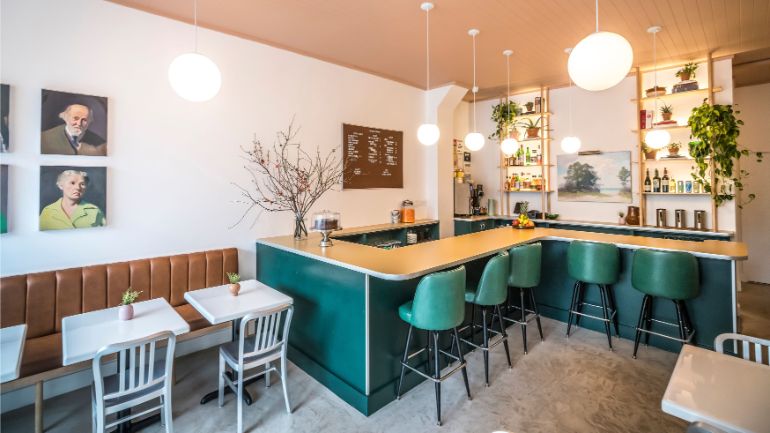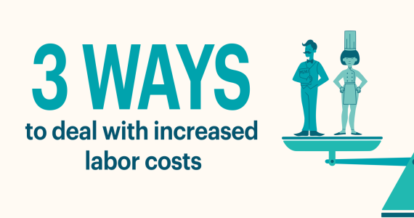Research shows that diversity and business performance go hand-in-hand. There is a significant correlation between having a more diverse team and financial performance.
So why is the restaurant industry behind when it comes to diversity and inclusion?
Brooklyn restaurant MeMe’s Diner has built their whole business around these practices and have seen the positive impact on staff, diners, and management alike.
Libby Willis, co-owner of MeMe’s Diner and member of the Eater’s Young Gun Class of 2019, shares what diversity and inclusion means for their business, as well as tips on building this environment at your restaurant.
MeMe’s Diner: A Space Where Everyone’s Welcome
MeMe’s Diner first opened their doors in November 2017.
Since then, the Brooklyn restaurant – named after co-owner Bill Clark’s grandmother – has thrived. Priding themselves on “familiar food prepared thoughtfully,” you’ll find a menu full of delicious options like stovetop mac and cheese, meatloaf, and Vietnamese iced coffee cake.
Besides a mouth-watering menu, MeMe’s Diner is known for being a space where everyone is welcome. You won’t hear servers referring to the “guys” or the “ladies” at a table – gendered language is out at this Brooklyn restaurant.
“There are ways we get around using gendered language,” Libby says. “If you ever hear me using gendered language, remind me to use y’all or friends or folks.”
Taking out gendered language is part of their restaurant’s mission of creating a familiar and welcoming environment. “If you’re not queer friendly, then it’s not welcoming,” she explains. “But it doesn’t have to be specific to queer issues, because we truly believe hospitality means caring for everyone and treating everyone equally, so it’s pretty easy for us to maintain.”
Having this open dialogue has not only been great for their mission and culture, but the profitability of their business. “We keep our staff,” Libby shares, citing this to the inclusive culture they have built at MeMe’s. “We don’t have high turnover because people feel comfortable.”
And the comfortable environment they’ve created for their staff doesn’t end there: the diners feel that same welcoming and inclusive environment. “There’s good vibes in the restaurant. It trickles down into the atmosphere.”
Despite the success MeMe’s Diner has found with a business rooted in inclusion, Libby knows there’s a lot of change needed in the industry as a whole. “When it comes down to it, your [staff are] coming to this restaurant maybe for four days a week, for eight to 12 hours a day and that environment is what we really need to change.”
Diversity in the Restaurant Industry
And that change is desperately needed.
A study by the Restaurant Opportunities Center revealed how skewed positions held in the restaurant industry are, based on gender or race:
- Men held 74% of management positions, compared to 26% of women
- White workers held 81% of observed FOH management positions compared to workers of color
Numbers don’t lie – a lack of hiring practices that encourage diversity and inclusion in restaurants is an issue that affects every level of a restaurant.
Even industry institutions are being called out for the lack of diversity. The James Beard Awards, after being criticized for lack of diversity, are implementing changes to their rules and regulations to make the awards more inclusive. The World’s 50 Best Restaurants List made a public statement to have 50/50 gender balance on its voting academy.
It’s proven time and time again that businesses benefit from inclusion and diversity. In fact, according to Forbes:
- Inclusive business teams make better business decisions 87% of the time
- Teams that follow an inclusive process make decisions twice as fast with half the meetings
- Decisions made and executed by a diverse team delivered 60% better results
Take these trends and apply them to your business. Having a diverse workforce will not only impact your business decisions, but your customer experience. Imagine if your team was making decisions twice as fast – from what special to feature to who’s working what table. Having a team that’s able to make better decisions faster means they’ll be able to spend more time focusing on improving guest experience, connecting with your diners, and building your culture.
When you create a team that’s comfortable with each other, that comfort will naturally translate to diners. Making changes now to ensure your workplace embraces diversity keeps you ahead of the curve and improves your business.

Creating Your Culture: Where to Start
The way your business runs on a daily basis forms your restaurant culture, whether you’re actively working on it or not.
If you aren’t making efforts to mould your culture, you should start – our State of Full Service Restaurants Report found that 41% of respondents were actively working on company culture as a way to find and keep a great team.
You want your restaurant’s brand to help create an environment that embraces diversity and strives to make staff feel safe. It’s the cornerstone to a healthy workplace culture.
Whether you want to refresh your current inclusion practices or implement new ones, check out these tips from Libby at MeMe’s Diner to create a more inclusive and safe work environment.
1) Set Expectations Early
The people you employ are a direct reflection of your restaurant’s mission. Make sure your standards are clear to potential hires from the start. This will keep people in the interview process who agree with your values and quickly remove people who don’t.
Libby and Bill are upfront with potential hires at the start of the interview process to ensure the people they bring into their business enhance the culture they have created.
“We take a public approach to being open that we are here, no questions asked. We are queer people who love queer people and are queer friendly,” Libby says. “That’s in our hiring practices, our policy on how we treat each other, and it goes beyond our state mandated laws.”
2) Be Aware of the Law
While your hiring practices should go beyond state mandated laws, there are equal employment opportunity laws in place.
Take the time to educate yourself on the laws in your area. It’s important for you to know the best ways for you to protect your staff, but it’s also key for staff to be aware of what laws protect their day-to-day work environment.
As a restaurant owner, you’re aware of the laws around serving liquor, labor laws, and restaurant licensing – these laws are just as important to be educated on.
“There are plenty of resources on the Internet to understand what the laws are and how you can enforce them into an equitable environment,” Libby says.
And she’s not wrong. If you’re unsure where to start, the U.S. Equal Employment Opportunity Commision (EOCC) offers great resources as a starting point. EOCC offers a section with specific resources for small businesses, making it easier for you.
Some of the resources covered include:
- Checklists for creating employee policies, including general-non discrimination and harassment policies
- Best practices for disability and religious accommodation for your staff
- Employee training tips – a great place to find tips for including your workplace expectations on inclusion for staff
- Checklists for how to effectively train managers to understand and consistently enforce your discrimination rules and policies
Check out their full list of small business tips here.
3) Speak Up
One of the best – and easiest – ways to build this type of culture is by encouraging your staff to speak up, no matter the level or role. By creating a running narrative about inclusion and the impact of language, staff are comfortable holding each other accountable. “It’s giving people power to watch out for each other,” Libby says.
Having ongoing narrative also empowers your team to keep the conversation going, even if management isn’t in the room.
“It’s all about conversations,” Libby explains.
By speaking up, you get the chance to practice what you preach to your team.
“If you hear language that makes you uncomfortable or you can imagine would make someone uncomfortable, you have to say it in the moment and stop it,” Libby says. “Don’t pull someone off into a room and say, ‘Oh, I think that could make someone uncomfortable.’ The person who you think is being made uncomfortable also needs to know you’re watching out for them.”
When you create a space where holding each other accountable is the norm, gentle reminders in the moment feel like another day at the office instead of a behind-closed-door scolding.
Having this dialogue creates a better space for staff and diners alike: you reinforce to staff that you’re watching out for them and won’t tolerate behavior that makes them uncomfortable while forming a space that any diner can come in and feel welcomed.
4) Join the Narrative
Part of speaking up is joining in the narrative around diversity and inclusion in the workplace. Conversations about race, gender, and sexual orientation in the workplace shouldn’t be taboo.
As the restaurant industry shifts, conversations about these topics are becoming more commonplace. Joining the narrative is a great way to encourage industry conversation and learn from other restaurant owners.
Even for a restaurant that’s ahead of the curve with these conversations, Libby admits there’s a lot to learn from other owners: “Being open about what owners and managers will tolerate is an ongoing conversation that is in the forefront more now than ever before. We are lucky to be a part of that conversation and I am constantly learning from other people who are managing restaurants,” says Libby. “Those are conversations we all really need to be having and they need to evolve over time. It’s really exciting to be a part of.”
Another great way to join the narrative around these practices is by forming your own narrative – you don’t have to wait for somebody else to take the lead. Host networking events or industry nights. Bring in speakers that discuss these practices.
In fact, MeMe’s Diner did just this by hosting a series of industry nights specifically for queer people.
An important part of running a business is taking care of your people, staff and diners alike. By rooting your business practices in diversity and inclusion, you’re setting your business and staff up for success. These practices create a space that your staff and diners alike look forward – and feel safe – coming to.
And as a restaurant owner, that’s what it should be all about. As Libby says about their Brooklyn restaurant, “It’s really about feeling at home.”
Free job application template for restaurants







